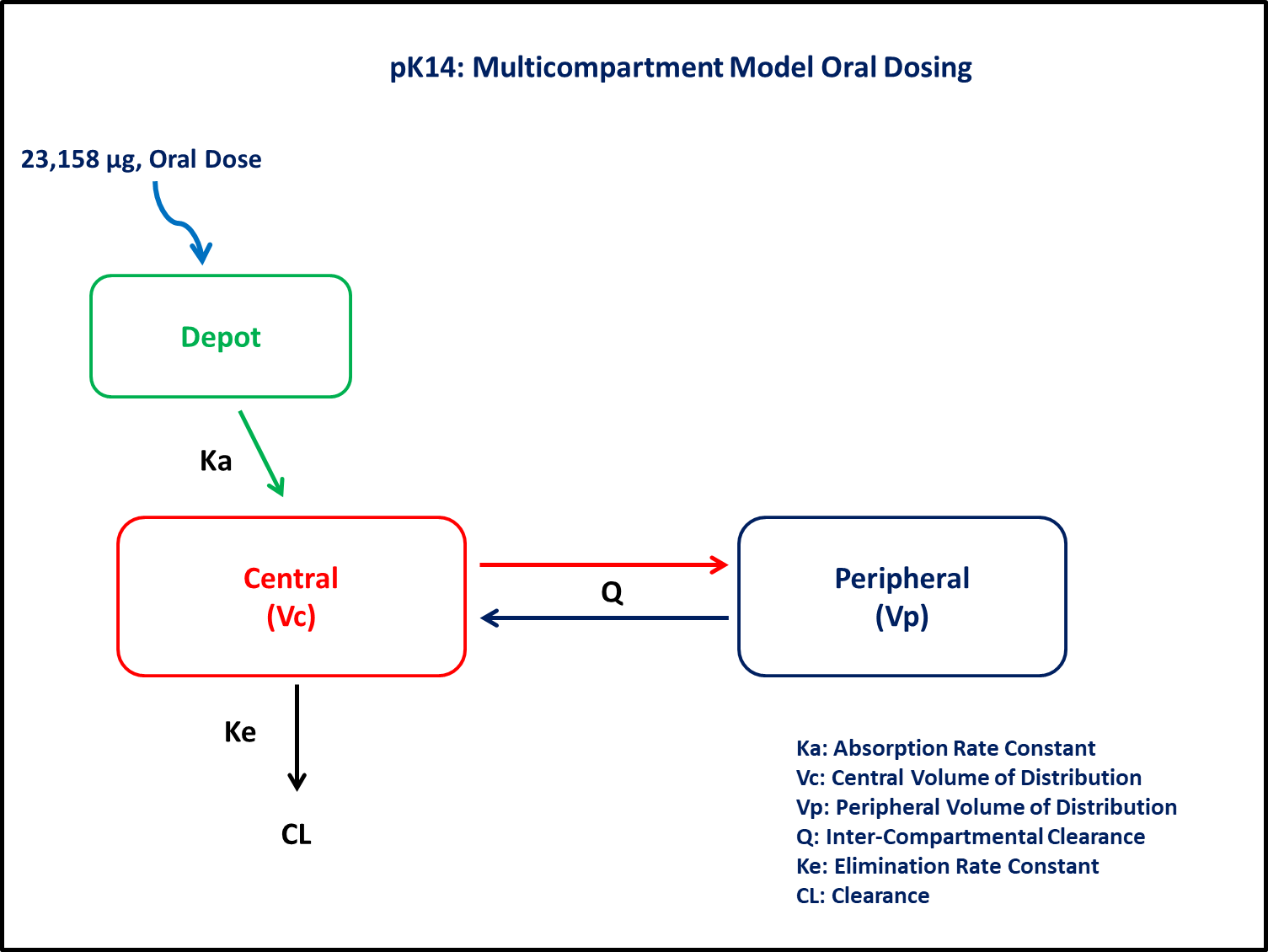using Random
using Pumas
using PumasUtilities
using AlgebraOfGraphics
using CairoMakie
using CSV
using DataFramesMeta
using Dates
PK14 - Multi-compartment model oral dosing
1 Background
- Structural model - Two compartment linear elimination and first order absorption with lagtime
- Route of administration - Oral
- Dosage regimens - 23,158 μg single dose
- Subject - 1

2 Learning Outcome
In this model, we will simulate an oral dose to understand the disposition of a drug following lag time in absorption
3 Objectives
In this tutorial, you will learn how to build a two compartment model with lag time in oral absorption and to simulate the model for a single subject.
4 Libraries
Call the necessary libraries to get started
5 Model
In this two compartment model, we administer doses to the Depot and Central compartments.
pk_14 = @model begin
@metadata begin
desc = "Two Compartment Model"
timeu = u"hr"
end
@param begin
"""
Absorption Rate Constant (hr⁻¹)
"""
tvka ∈ RealDomain(lower = 0)
"""
Volume of Central Compartment (L)
"""
tvvc ∈ RealDomain(lower = 0)
"""
Volume of Peripheral Compartment (L)
"""
tvvp ∈ RealDomain(lower = 0)
"""
Clearance (L/hr)
"""
tvcl ∈ RealDomain(lower = 0)
"""
Intercompartmental Clearance (L/hr)
"""
tvq ∈ RealDomain(lower = 0)
"""
Lagtime (hr)
"""
tvlag ∈ RealDomain(lower = 0)
Ω ∈ PDiagDomain(4)
"""
Proportional RUV
"""
σ²_prop ∈ RealDomain(lower = 0)
end
@random begin
η ~ MvNormal(Ω)
end
@pre begin
Ka = tvka * exp(η[1])
Vc = tvvc * exp(η[2])
Vp = tvvp * exp(η[3])
CL = tvcl * exp(η[4])
Q = tvq
end
@dosecontrol begin
lags = (Depot = tvlag,)
end
@dynamics Depots1Central1Periph1
@derived begin
cp = @. Central / Vc
"""
Observed Concentrations (μg/L)
"""
dv ~ @. Normal(cp, sqrt(cp^2 * σ²_prop))
end
endPumasModel
Parameters: tvka, tvvc, tvvp, tvcl, tvq, tvlag, Ω, σ²_prop
Random effects: η
Covariates:
Dynamical system variables: Depot, Central, Peripheral
Dynamical system type: Closed form
Derived: cp, dv
Observed: cp, dv6 Parameters
Parameters provided for simulation. Note that tv represents the typical value for parameters.
Ka- Absorption rate constant (hr⁻¹)Vc- Volume of central compartment (L)Vp- Volume of peripheral Compartmental (L)CL- Clearance (L/hr)Q- Intercompartmental clearance (L/hr)lag- Absorption lag time (hr)
param = (
tvka = 10,
tvvc = 82.95,
tvcl = 54.87,
tvq = 10.55,
tvlag = 0.078,
tvvp = 107.9,
Ω = Diagonal([0.04, 0.04, 0.04, 0.04]),
σ²_prop = 0.0125,
)7 Dosage Regimen
A single subject receives an oral dose of 23158 μg at time=0
ev1 = DosageRegimen(23158, time = 0, cmt = 1)1×10 DataFrame
| Row | time | cmt | amt | evid | ii | addl | rate | duration | ss | route |
|---|---|---|---|---|---|---|---|---|---|---|
| Float64 | Int64 | Float64 | Int8 | Float64 | Int64 | Float64 | Float64 | Int8 | NCA.Route | |
| 1 | 0.0 | 1 | 23158.0 | 1 | 0.0 | 0 | 0.0 | 0.0 | 0 | NullRoute |
sub1 = Subject(id = 1, events = ev1)Subject
ID: 1
Events: 18 Simulation
Let’s simulate plasma concentration after oral dosing
Random.seed!(123)The random effects are zero’ed out since we are simulating means
zfx = zero_randeffs(pk_14, sub1, param)(η = [0.0, 0.0, 0.0, 0.0],)sim_sub1 = simobs(pk_14, sub1, param, zfx, obstimes = 0.08:0.01:25)SimulatedObservations
Simulated variables: cp, dv
Time: 0.08:0.01:25.09 Visualization
@chain DataFrame(sim_sub1) begin
dropmissing(:cp)
data(_) *
mapping(:time => "Time (hours)", :cp => "Concentration (μg/L)") *
visual(Lines, linewidth = 4)
draw(;
axis = (;
yscale = log10,
yticks = map(i -> 10^i, 0:0.5:2),
ytickformat = i -> (@. string(round(i; digits = 1))),
xticks = 0:5:25,
),
figure = (; fontsize = 22),
)
end10 Population simulation
par = (
tvka = 10,
tvvc = 82.95,
tvcl = 54.87,
tvq = 10.55,
tvlag = 0.078,
tvvp = 107.9,
Ω = Diagonal([0.0152, 0.0426, 0.092, 0.0158]),
σ²_prop = 0.03,
)
ev1 = DosageRegimen(23158, time = 0, cmt = 1)
pop = map(i -> Subject(id = i, events = ev1), 1:68)
Random.seed!(1234)
sim_pop = simobs(
pk_14,
pop,
par,
obstimes = [0.08, 0.16, 0.25, 0.5, 1, 1.5, 2, 3, 4, 6, 8, 12, 24, 25],
)
sim_plot(sim_pop, yaxis = :log)
df_sim = DataFrame(sim_pop);
#CSV.write("pk_14.csv", df_sim)